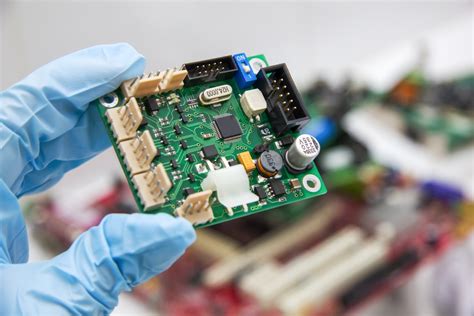What is Through-Hole Technology (THT)?
Through-Hole Technology (THT) is a PCB assembly process where component leads are inserted into drilled holes on the PCB and soldered onto the opposite side of the board. This method has been used for decades and is still popular for certain applications.
Advantages of THT
- Strong mechanical bonds between components and PCB
- Easier to visually inspect and manually repair
- Suitable for larger components and high-power applications
- More resistant to vibration and mechanical stress
Disadvantages of THT
- Larger PCB size due to the need for drilled holes
- Slower assembly process compared to SMD
- Higher manufacturing costs for high-volume production
- Limited component density on the PCB
What is Surface Mount Device (SMD)?
Surface Mount Device (SMD) is a PCB assembly process where components are mounted directly onto the surface of the PCB without the need for drilled holes. SMD has gained popularity in recent years due to its numerous benefits, particularly in high-volume production and miniaturization.
Advantages of SMD
- Smaller PCB size and higher component density
- Faster assembly process using automated pick-and-place machines
- Lower manufacturing costs for high-volume production
- Improved high-frequency performance due to shorter lead lengths
Disadvantages of SMD
- More difficult to manually repair and rework
- Requires specialized equipment for assembly and inspection
- More susceptible to thermal stress during soldering
- Not suitable for high-power applications or large components
Comparing THT and SMD
To better understand the differences between THT and SMD, let’s compare them based on several key factors:
| Factor | THT | SMD |
|---|---|---|
| PCB Size | Larger due to drilled holes | Smaller and more compact |
| Component Density | Lower | Higher |
| Assembly Speed | Slower | Faster with automated machines |
| Manufacturing Cost (High-Volume) | Higher | Lower |
| Mechanical Strength | Stronger bonds | Weaker bonds |
| Rework and Repair | Easier | More difficult |
| High-Frequency Performance | Inferior due to longer lead lengths | Superior due to shorter lead lengths |
| Suitability for High-Power Applications | More suitable | Less suitable |

Choosing Between THT and SMD
When deciding between THT and SMD for your PCB assembly process, consider the following factors:
-
PCB Size and Component Density: If your design requires a compact PCB with high component density, SMD is the better choice. However, if you have larger components or need a more spacious layout, THT may be more suitable.
-
Production Volume: For high-volume production, SMD is generally more cost-effective due to faster assembly speeds and lower manufacturing costs. THT is better suited for low-volume or prototype production.
-
Mechanical Strength: If your PCB will be subjected to vibration or mechanical stress, THT provides stronger bonds between components and the board. SMD is more susceptible to mechanical stress and may require additional reinforcement.
-
High-Frequency Performance: For high-frequency applications, SMD offers superior performance due to shorter lead lengths and reduced parasitic capacitance and inductance.
-
Rework and Repair: If you anticipate the need for manual repairs or rework, THT is easier to work with as components can be individually replaced. SMD requires specialized equipment and skills for rework.
Frequently Asked Questions (FAQ)
-
Q: Can THT and SMD components be used together on the same PCB?
A: Yes, it is possible to use both THT and SMD components on the same PCB in a process called mixed-technology assembly. This allows designers to take advantage of the benefits of both methods while accommodating specific component requirements. -
Q: Is it possible to convert a THT design to SMD?
A: In most cases, it is possible to convert a THT design to SMD. However, it may require modifications to the PCB layout, component selection, and assembly process. It is essential to consider the specific requirements and constraints of the design before making the conversion. -
Q: Which PCB assembly process is better for prototyping?
A: THT is often preferred for prototyping due to its ease of manual assembly and rework. SMD can also be used for prototyping, but it may require specialized equipment and skills, which can increase the cost and time for low-volume production. -
Q: Are there any environmental concerns with THT or SMD?
A: Both THT and SMD assembly processes use lead-based solder, which can have environmental and health implications if not handled properly. However, there are lead-free solder options available for both methods that comply with RoHS (Restriction of Hazardous Substances) regulations. -
Q: How do I choose a PCB assembly service provider for my project?
A: When selecting a PCB assembly service provider, consider factors such as their experience with your specific assembly method (THT or SMD), their manufacturing capabilities, quality control processes, and customer support. It is also essential to review their pricing, lead times, and minimum order quantities to ensure they align with your project requirements and budget.
Conclusion
Choosing between THT and SMD for your PCB assembly process depends on various factors, including PCB size, component density, production volume, mechanical strength, high-frequency performance, and rework requirements. By understanding the advantages and disadvantages of each method and considering your specific project needs, you can make an informed decision on which PCB assembly process is better suited for your application.
Ultimately, both THT and SMD have their place in the world of PCB assembly, and the choice between them is not always clear-cut. In some cases, a combination of both methods may be the best approach. By working with an experienced PCB assembly service provider and keeping an open mind to the possibilities offered by each method, you can ensure that your PCB design is optimized for manufacturability, reliability, and performance.






Leave a Reply